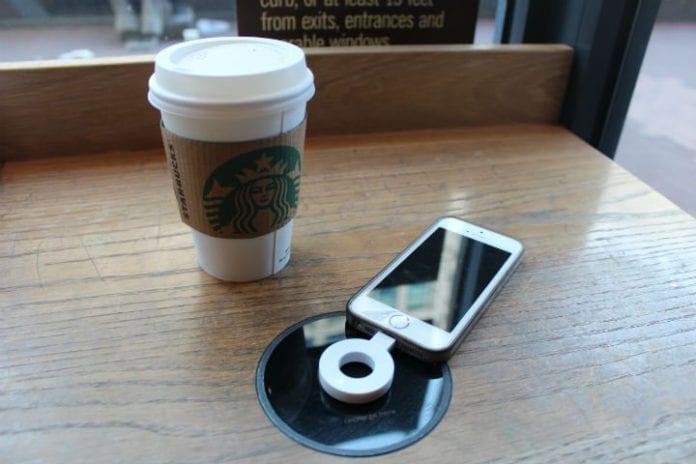This has turned out to be a banner year for wireless charging.
If you doubt that claim, peer into any one of 200 Starbucks coffee shops in San Francisco and around the United Kingdom where you will find customers wirelessly charging their smartphones and other devices on small circular “Powermat Spots” built into community tables. Or step into a 2016 Kia Optima or BMW 7 Series vehicle and power your favorite device on charging pads built into the car’s center console. And for that matter, forget about plugging your smartphone into the wall socket before bed. Instead, simply rest it on an Ikea nightstand with built-in wireless charging.
Wireless charging is as hot as it’s ever been, in large part because standards bodies, manufacturers and retailers all seem keen on moving it along. In fact, Juniper Research predicts nearly 40% of U.S. households and 20% of European households will adopt wireless charging by 2020. And the market for wireless power transmitters and receivers is expected to move from 55 million units shipped in 2014 to more than 2 billion units in 2024, according to IHS Technology. The growth could be even more significant than that.
Wireless charging was already off to a great start with first-generation “inductive technology,” a powering process that uses two coils – a transmitter and a receiver. It works by passing an alternating current through a transmitter coil and generating a magnetic field, which induces a voltage in the receiver coil that powers mobile devices and batteries. It’s essentially the same technology that powers electric toothbrushes and razors when they’re placed into counter-top charging stations.
Inductive technology has been good enough to convince many retailers, automakers, financial institutions and other businesses to try it out. Indeed, it is turning up in stores, restaurants, train stations and airports – even Madison Square Garden is using it.
But inductive technology also has some limitations the industry must address. First and foremost, it only allows users to charge one device at a time. And that device must be placed in just the right position on the charging spot or it won’t make a proper connection. If it sits beside, above or below the power source, it won’t charge. So you can imagine how that might annoy motorists who think they’re charging their mobile device only to learn that it shifted when the car rolled over that last speed bump.
These types of challenges with inductive technology are the main reason many analysts predict that, over time, inductive technology will be overtaken by a technology known as “resonant” wireless charging technology. In fact, IHS predicts resonant will overtake inductive technology by 2019. Resonant technology utilizes a simple transmitter designed for multiple receiver support, which means users can simultaneously charge several devices at a time, such as smartphones, wearables and tablets.
The comprehensive wireless power control system, combined with Bluetooth Smart communication, also makes it possible to deliver power wherever it is needed and manage multireceiver charging in a comprehensive way. These benefits, among others, are leading equipment manufacturers and standards bodies to place more attention on making resonant wireless charging a reality for the masses.
Until recently, the notion of making wireless charging available to the masses seemed unlikely because the three major wireless power standards bodies couldn’t agree on a single specification. But earlier this year, two groups – the Alliance for Wireless Power and the Power Matters Alliance – raised hopes when they agreed to merge into a combined organization known as the AirFuel Alliance. Now, only the Wireless Power Consortium and the AirFuel Alliance are vying to set the agenda for wireless charging. Fortunately, both groups are cognizant of the need to usher in next-generation resonant technology.
Within the newly formed AirFuel alliance, resonant technology has been developed for years under the A4WP standard. The WPC, whose Qi standard is the longest-standing spec for inductive wireless charging, has announced it will enable support for resonant charging via an evolution of Qi.
Standards wars are par for the course in the technology industry and goes way back. About 125 years ago, for example, Thomas Edison and Nikola Tesla fought a “war of current,” with Edison promoting direct current and Tesla backing alternating current. Of course, the AC camp won the battle, but 125 years later we see both alternating and direct current being used, each having their own specific purpose and advantage.
In addition to the consolidation on industry standards bodies, Samsung and several other original equipment manufacturers are rising above the fray by integrating multimode receivers into their devices, making them compatible with both Qi and AirFuel transmitters.
The bottom line is that wireless charging deployments are gaining speed and what we’re seeing now is just the tip of the iceberg. With consolidation of standards bodies, commitment by device makers and increased consumer awareness, most of us will be cutting the cords for powering-up within a year or two. Count on it.
Reinier van der Lee serves as product line director of the broadband and connectivity group at Broadcom, and is responsible for the product definition and marketing of power management chips for mobile devices. Reach the author @broadcom.
Editor’s Note: In an attempt to broaden our interaction with our readers we have created this Reader Forum for those with something meaningful to say to the wireless industry. We want to keep this as open as possible, but we maintain some editorial control to keep it free of commercials or attacks. Please send along submissions for this section to our editors at: [email protected].

